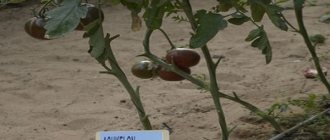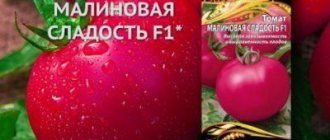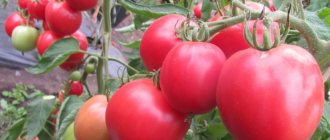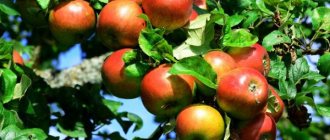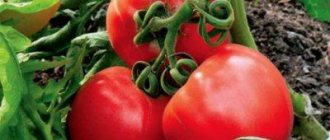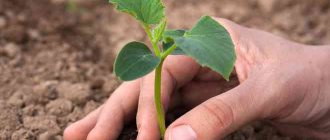general information
This variety of tomato is not included in the register of breeding achievements of the Russian Federation. It is being successfully implemented both in Russia and in Belarus, Lithuania and Ukraine.
The tomato has gained particular popularity among those gardeners who are looking for high-yielding and transportable varieties with a high marketable yield.
It is also important that “Moneymaker” is an early variety, and if technology is followed and grown in greenhouses, it can give a good harvest of early, expensive products.
Tomato varieties by growing method
All varieties and hybrids of tomatoes are divided according to the method of cultivation. Some are well suited for open ground, others need to be grown under temporary film covers, in unheated or heated greenhouses, but there are also those that will feel good on a balcony or windowsill, in a very small container, and at the same time give an excellent harvest.
| Name of variety/hybrid | For open ground | For heated greenhouses | For unheated film greenhouses | For film shelters (greenhouses) |
| St. Andrew's surprise | + | + | ||
| Orange | + | + | ||
| Appetizing | + | |||
| Balcony miracle | + | |||
| Ballad | + | |||
| Boni MM | + | + | ||
| Bull forehead | + | |||
| Bull's heart | + | + | ||
| Knight | + | |||
| Flash | + | |||
| Gavroche | + | |||
| Pink pear | + | |||
| Lady fingers | + | + | ||
| De Barao | + | + | ||
| Dessert | + | |||
| wild Rose | + | + | ||
| Elisha | + | + | ||
| Fatty F1 | + | + | ||
| Golden Andromeda F1 | + | |||
| Golden heart | + | |||
| Golden domes | + | |||
| Ivan - yes - Marya F1 | + | + | ||
| Raisin F1 | + | + | ||
| Kyoto | + | + | ||
| Consul F1 | + | + | ||
| Market King VII F1 | + | |||
| Kuban | + | |||
| Pendant | + | |||
| Ladoga | + | |||
| Legionnaire F1 | + | |||
| Lel | + | |||
| Leah | + | |||
| Long keeper | + | + | + | |
| Bear Paw | + | |||
| Millennium F1 | + | |||
| Misora F1 | + | |||
| Monty F1 | + | |||
| Muscovy | + | |||
| Moscow delicacy | + | |||
| Negro | + | + | ||
| New from Transnistria | + | |||
| New Year | + | |||
| Orange giant | + | |||
| Orlik | + | + | ||
| Orpheus F1 | + | |||
| Excellent student F1 | + | |||
| Patriot F1 | + | + | ||
| Peremoga 165 | + | + | ||
| Petrusha the gardener | + | |||
| Picolino F1 | + | |||
| Pinocchio | + | |||
| Pioneer | + | |||
| Winner | + | |||
| Gift from Kuban | + | |||
| Podmoskovny F1 | + | |||
| Pozharsky F1 | + | + | ||
| Poznan | + | + | ||
| Poltava F1 | + | |||
| Pole | + | |||
| Raisa F1 | + | |||
| Paradisaic delight | + | + | ||
| Ruslan | + | + | ||
| Sanka | + | |||
| Northern miracle | + | |||
| Senator F1 | + | + | ||
| Siberian giant | + | |||
| Siberian malachite | + | + | ||
| Silhouette F1 | + | |||
| Sicilian pepper | + | |||
| Yellow cream | + | + | ||
| Red cream | + | + | ||
| Slivka Moskovskaya | + | + | ||
| Pink cream | + | + | ||
| The Snow Queen | + | |||
| Soviet | + | + | ||
| Spartak F1 | + | |||
| Octopus F1 | + | + | ||
| Start | + | |||
| Stepashka F1 | + | |||
| Strategist F1 | + | |||
| Drying F1 | + | |||
| T-34 | + | |||
| Taman F1 | + | + | ||
| Tamerlan F1 | + | + | ||
| Tanya F1 | + | |||
| Timofeich | + | |||
| TMAG 666 F1 | + | |||
| Fat neighbor F1 | + | |||
| Tomala F1 | + | |||
| Torero F1 | + | |||
| Toropyzhka F1 | + | + | ||
| Tristar F1 | + | |||
| Triumph | + | |||
| Turandot | + | + | + | |
| Tourist F1 | + | + | ||
| Uvalen | + | + | ||
| Favorite 6 F1 | + | |||
| The Tsar Bell | + | |||
| Chereshenka | + | + | ||
| Black Baron | + | + | ||
| Black Moor | + | + | ||
| Black Prince | + | + | ||
| Cherry raspberry | + | |||
| Cherry with cream F1 | + | + | ||
| Chizhik | + | |||
| Cio-chio-san | + | |||
| Wonder of the world | + | |||
| Shakira F1 | ||||
| Monomakh's hat | + | + | ||
| Chocolate | + | |||
| Shuntuk giant | + | |||
| Generous cascade | + | + | ||
| Sherbet F1 | + | |||
| Eijen F1 | + | + | ||
| F1 crew | + | |||
| F1 exclusive | + | |||
| Extreme | + | + | ||
| Elton John F1 | + | + | ||
| El Dorado | + | + | ||
| Emrero F1 | + | |||
| Effect | + | + | ||
| Anniversary of the Moscow region | + | |||
| Jubilee F1 | + | + | ||
| Junior F1 | + | |||
| Jurand F1 | + | |||
| Yuryevsky | + | |||
| Yuhas | + | |||
| Yamal 200 | + | + | ||
| Amber 530 | + | |||
| Japanese crab | + | + | ||
| Jap | + | |||
| Yuppie | + | + | ||
| Bright Malinovka | + | + | ||
| Yaroslav | + | |||
| Yasik F1 | + | + | ||
| Yakhont | + |
Characteristics and description
The vegetative form of this tomato variety is indeterminate, tall, with fairly powerful shoots that are capable of bearing a huge harvest of fruit.
The height of the shoot reaches 1.8, or even 2 meters. Grow the plant in 2-3 stems with constant formation and tying.
Fetus
"Moneymaker" is a typical tomato. The fruits are collected in beautiful, uniform clusters, and from 7 to 12 fruits are formed.
The first brush is placed above the 7th sheet, the rest after 2-3. Since the variety tolerates drafts, unfavorable weather conditions, temperature changes very well and at the same time shows excellent setting, the brushes are all full.
Tomato fruits are even, with a difference of several grams. Round, even, smooth, glossy, they look great on the brush when fully ripe.
The color of the tomatoes is bright, but not deep red. They ripen gradually, but this fact is even more suitable for those gardeners who grow tomatoes for sale on the market.
The weight of the tomato is 90-100 g. These fruits do not come in larger sizes and are a classic for placing in cans.
Mandatory care requirements
You can count on a good harvest of tasty red tomatoes if you follow the most necessary requirements for caring for the bushes themselves. First of all, this concerns watering the area with warm, settled water. The procedure must be repeated every 4 to 7 days, depending on the degree of drying of the soil. If you choose between prolonged drought and excess water with the formation of puddles on the soil, then preference should be given to the first option. Tomato Magnat is more resistant to lack of timely watering, but with excessive humidity that does not allow oxygen to pass through, the root system begins to deteriorate and rot.
The second important point concerns the complete removal of weeds on the site, which not only prevent the tomato bushes from being fully illuminated, but also interfere with the saturation of the root system with air, moisture, as well as micronutrients from the applied complex fertilizers. Regular loosening of the soil will prevent the formation of dense earthen crusts, which means it will prevent damage to the root system and the onset of its rotting.
As for fertilizers, you can use both mineral complexes and organic substrates, for example, mullein solution. It is better to alternate them with each other. In total, in the process of growing tomatoes, fertilizer is used no more than 3-4 times with a break of at least three to four weeks. Water containing mineral or organic matter should be directed to the roots of plants without affecting the green foliage.
To get a good harvest, you need to use high-quality seeds. The most productive varieties are possible. Large selection of varieties for every taste.
Resistance to diseases and pests
This variety is presented as resistant to the most virulent tomato diseases. However, those vegetable growers who have already grown claim that the “Moneymaker” tomato, the characteristics and description of the variety do not quite reflect the essence and the variety is not very resistant to late blight.
There is a need for preventive spraying with fungicidal preparations even when grown in greenhouses, so you need to regularly inspect the plantings and carry out timely treatments.
There is information that the variety is affected by cladosporiosis (brown spot), which also imposes peculiarities in processing.
results
We've reached the most interesting part. Here I think that everything worked out. A minimum number of articles have been published, there is traffic, comments from real visitors appear periodically.
Monetized not aggressively. Upon completion of the marathon, the payback period was approximately 11 months. Due to A/B tests and the additional connection of contextual advertising, this period could be further reduced. It didn't come to that because the site was sold.
The proposal that was received slightly exceeded 20 months of payback. And due to the fact that the Leadia PP manager approved the preservation of improved rates for leads coming from the site to the new owner, the cost was more than 25 months of payback. The costs of training and creating a website were fully recouped, and even more.
Advantages and disadvantages
When looking for varieties to plant in the garden, each vegetable grower puts his own meaning into the word “quality”. Considering “Moneymaker”, the following advantages of the variety can be noted:
- high productivity;
- excellent product yield;
- excellent transportability;
- good keeping quality.
For those vegetable growers who value taste first of all in tomatoes, this variety is definitely not suitable. The following disadvantages can be noted:
- not salad taste;
- the need for stepsoning and shaping;
- weak resistance to diseases.
Site selection and soil preparation
Tomato beds are planted in well-lit, windless areas. Lowlands and places where groundwater lies high are absolutely not suitable - there is a high chance of picking up a fungus.
Please note: when cultivating tomatoes, it is worth observing crop rotation. It is best to arrange a tomato bed after zucchini, carrots and onions. But where nightshades previously grew, it is better not to plant tomatoes
But where nightshades previously grew, it is better not to plant tomatoes.
The soil should be slightly acidic or neutral. Loamy soil is also suitable, but it will need to be additionally fertilized. When planting the beds, organic fertilizers and superphosphate are added to the ground. The seedlings are planted in separate holes, to the bottom of which ash is added.
Tip: Before planting, the beds are watered with a hot solution of potassium permanganate. Consumption – 3 liters per square meter.
Since Kmitsa bushes are low-growing, they can be planted more often. Holes are placed every 35-45 centimeters. The row spacing is 50 centimeters. You can place 7-9 plants on one square meter. The depth of the holes is 20 centimeters.
To plant tomatoes in the garden, you need to choose cloudy days or evening time. The bushes are carefully removed from the seedling container and inserted into the hole, sprinkled with earth. If the seedlings have outgrown, then they are placed in a hole, slightly tilted. Normal seedlings are planted strictly vertically. The tomato planting field is not watered to avoid the formation of an earthen crust.
Tip: the seedlings need to be removed from the cup along with the earthen lump. In order for the soil to easily move away from the walls of the container, the soil needs to be watered generously an hour or two before the procedure.
Features of cultivation
When describing the advantages of the variety, one of the points was high yield. However, whatever the genetic potential, it is difficult to achieve high productivity without balanced feeding.
Seedling period
The start of the shoot is given by proper cultivation during the seedling period. The tomato is early ripening, so there is no need to sow it in February; the first days of March are quite optimal.
If you can take less fertile soils for sowing, then for diving you need universal soil mixtures, seasoned with complex fertilizers. They will allow the seedlings to reach a form that, when planted in a greenhouse or open ground, will immediately begin to grow and begin to set fruit.
When growing a variety, you should adhere to certain rules:
- Moneymaker tomatoes definitely need to be grown with seedlings picked. This manipulation will allow you to convert the root system into a fibrous system and significantly increase the feeding area;
- In order for the root system to master the entire earthen ball and reach the bud-laying phase in a timely manner, an optimal amount of soil is needed in an individual container;
- The plant is tall and there is nothing to worry about if it stretches out a little.
Experienced vegetable growers sow in a common container and plant in individual 200 ml cups. When the root has mastered the earthen ball, transfer it into a 500 ml container and from there transplant it into open ground or a greenhouse.
Description of the Moneymaker tomato variety
In order not to make a mistake when choosing nightshade crops for your summer cottage, you need to study in detail the description and characteristics of each variety. You need to choose tomatoes based on the purpose of their cultivation. Some varieties are suitable exclusively for preservation, while others are distinguished by their universal use.
Tomatoes of the Moneymaker variety were bred by breeders from Holland. The seed producer is the agricultural company Sedek. Refers to early ripening. The first red tomatoes can be harvested 90–100 days after germination.
One of the main advantages of the variety is that it is suitable for planting both in open and closed ground (in greenhouses and greenhouses). Also, it is considered one of the best varieties for planting in greenhouses.
The Moneymaker variety of tomatoes should be grown only on fertile soils. If the soil is poor, the fruits will be small, the bushes will be short, and the harvest will be poor. Even if a large amount of mineral and organic fertilizers is applied, the variety will still grow very poorly.
It is unpretentious and does not require special care. Fruiting continues until the cold weather. Even in the fall, you can pick the fruits and preserve them green.
The Moneymaker tomato variety is not susceptible to the development of most diseases of nightshade crops.
Basic qualities of fruits
Usman tomatoes are distinguished by excellent commercial qualities, uniform size and shape, and these indicators do not change throughout the entire growing season. The fruits are classified as large, weighing between 180–200 g (sometimes larger specimens weighing 250 g are found). The shape of the berries is flat-round, with medium ribbing; a large number of fruits have a characteristic nose. Tomatoes are dense, therefore they are highly transportable, have good shelf life and are resistant to cracking.
Unripe fruits are colored light green, ripe berries are bright, dark red. Tomatoes are multi-chambered, each with 6 or more nests.
Money spendings
A film greenhouse does not require large financial outlays and can be built with your own hands. You will have to tinker with a glass greenhouse, but it will last you much longer. You can also purchase a hydroponic setup.
To get an early harvest, you need to know a few things about tomatoes.
According to the type of growth, they are of three types:
- Low-growing (from 30 cm to 1 m, form from 3 to 5 flower-fruit clusters and are distinguished by their early ripening
- Medium height (from 100 cm to 150 cm
- Tall (height up to 2.5 m)
Take this into account when planning your greenhouse. The ceiling height should be sufficient for the selected types of tomato.
Beginner gardeners usually buy ready-made tomato seedlings for film greenhouses. It is better to do this at companies that specialize in growing tomato seedlings, among others. Such seedlings already have buds in the flower cluster and are hardened. Pay attention to the color of the plants. They should be bright green, fresh and with strong stems.
Characteristics of tomato Manikaker
The bushes are tall (indeterminate), the main stem can reach up to 2 meters in height. In this regard, the plant must be tied up. Stepsonning is also necessary. The best results from growing tomatoes can be obtained if you form the bushes into 3 main stems. The bushes are heavily leafy.
Tomatoes ripen in clusters, so they are not very large. The weight of one fruit can reach up to 100 grams. Vegetables ripen together. The shape of ripe fruits is round. The skin is smooth, not ridged, and quite dense. Unripe vegetables are light green in color and gradually acquire a beautiful scarlet color.
Characteristics and description of the Han tomato varietyRead
Very productive, one adult plant can produce up to 10 kg of vegetables. To get the maximum amount of harvest, the bushes need to be planted at a distance of 50 cm from each other, the distance between the rows should be at least 70-80 cm. Per 1 sq. m. m. there should not be more than three bushes.
Ripe fruits can be eaten fresh and used in summer salads. They are also excellent for canning, preparing tomato juices, lecho, pastes and whole pickling.
Features of agricultural technology of the Money Bag variety
The Moneybag tomato is an early tomato, grown through seedlings, and then it is recommended to plant it in a greenhouse.
Sowing seedlings
The usual time for planting crops in greenhouse conditions is May or early June. You need to navigate by the climate of the area and weather conditions, and your own experience. The calculation is made based on the fact that at the time of planting the seedlings should be about 60 days old. It is necessary to add 5-7 days that are needed for the emergence of seedlings, as a result, you get the approximate sowing time.
Most often they are sown in early or mid-March, then the seedlings will be ready for transplanting by the end of May.
Seeds need to be prepared:
- carry out etching in potassium permanganate or Maxim;
- soak in any growth stimulant (Epin, sodium humate, as well as ordinary wood ash are excellent for these purposes);
- harden at a temperature of minus 1 degree (on a shelf in the refrigerator, time - about a day);
- Germinate seeds in damp cloth.
Seed treatment should not be ignored. Such procedures do not require much time, but they ensure uniform germination of seed material and help increase the immunity of future plants to various diseases.
The soil for sowing and the containers in which the tomatoes will grow must be prepared in advance. They use boxes, containers, large wide jars, where tomatoes are first sown in batches (it’s convenient to do this by variety), and only then picked into separate containers.
ON A NOTE! Picking ensures more uniform growth of the tomato root system and eliminates the stretching of seedlings.
Some gardeners use peat pots and various boxes (from juice, dairy products) to grow tomatoes.
Two or three days before sowing, it is recommended to spill the prepared soil with a solution of potassium permanganate for disinfection. Sow the seeds in small furrows, carefully placing the seeds with tweezers. Sprinkle with soil, cover with film and put in a warm place.
The temperature should be within +23ºC…+25ºC.
When the first tender sprouts appear, the cover is immediately removed and the tomatoes are placed in a bright place.
Seedling care
At this time, there is a high risk that the tomato sprouts may stretch out. Therefore, it is necessary to slightly reduce the temperature to +18ºC and maintain this regime for about 5-6 days.
Tomatoes should be watered only when the soil dries out, avoiding excess moisture. Limiting watering promotes the growth of strong, non-stretched seedlings. It is convenient to water the seedlings with a pipette, then the soil will not be washed away and moisture will not get on the leaves.
After a week, a stable temperature regime is set at +23ºC…+25ºC, at night – up to +18ºC. If there is a lack of light and a lot of cloudy days, tomatoes should definitely be supplemented with additional light. It is better to use fluorescent lamps or special phytolamps.
As soon as two or three true leaves have appeared, the tomatoes are ready for picking. Before the procedure, it is advisable to water the seedlings 2-3 hours before, so that they are easier to remove from the soil when replanting.
After picking in cups or pots, lower the temperature for a couple of days and shade the plants from the bright sun. Subsequent care before planting includes watering as needed, fertilizing (it will be enough to feed the Money Bag seedlings twice), and careful loosening.
Planting seedlings and caring for tomatoes in a greenhouse
Tomatoes can be planted in a greenhouse from the beginning of May (middle zone). In regions with a more severe climate, even under shelters, plants may be cool at this time, so it is recommended to wait for stable heat and warming of the soil to +16ºC (at a depth of 10-12 cm).
ON A NOTE! To create comfortable conditions for tomatoes in the first days after planting, they can be covered with non-woven material.
Variety Money Bag is planted with 3-4 plants per square meter. The holes are spilled with water, humus and superphosphate are added, mixed and the seedlings are planted. Sprinkle with soil and lightly compact. It is recommended to immediately mulch the plants.
The tomatoes have not been watered for about a week. If the days are sunny, then in the first 48 hours after transplanting the tomatoes should be protected from bright rays.
You also need to equip the greenhouse with supports for trellises in advance or install supports near each bush. Subsequently, the garter must be done using wide cotton ribbons (ropes and twine cannot be used).
The following are standard agricultural techniques:
- watering;
- feeding;
- loosening;
- bush formation.
Tomatoes have a high moisture requirement, so they water abundantly, but rarely. It is necessary that the optimal air humidity in the greenhouse is no more than 70%. They increase volumes during the budding phase, the period of flowering and fruit formation.
Water at the roots, not allowing drops of water to fall on the plants themselves. It is convenient to water in grooves or specially outlined circles around plants; drip systems are also effective.
IMPORTANT! Greenhouses must be ventilated to prevent high humidity inside the shelter.
After watering, it is recommended to loosen the soil if mulching has not been carried out previously. Mulch helps conserve moisture, prevent the soil from drying out, and gets rid of weeds. Suitable for mulching:
- rotted compost;
- peat;
- mown grass;
- straw.
Organic matter is used for fertilizing (during the first growing season), then potassium and phosphorus fertilizers are applied. Nitrogen fertilizing is necessary only if the plants are not growing well; a deficiency of this substance is noticeable in the leaves and general condition. If the soil was well fertilized before planting, manure or bird droppings are then not added in order to prevent the tomatoes from becoming fattened.
In total, for a productive Money Bag you need to fertilize 4-5 times during the season. A lot of fruits are formed on the tomato clusters; the plant needs additional good nutrition. Using “green” fertilizer gives excellent results:
- cut grass is poured into the barrel (nettle is especially good);
- fill it with warm water to the top;
- cover with a lid and leave for 10 days to infuse.
After the infusion is ready, add a liter of it to a bucket of water and water the tomatoes. Such fertilizing improves the appearance of plants and increases fruit formation.
Gardeners also use various foliar feedings, which at the same time serve as prevention against various infections:
- ash composition;
- yeast solution;
- iodine solution;
- boric acid solution.
It is better to spray in the evening, then the composition will dry out slowly and be better absorbed by the leaves.
The plants must be pruned, leaving stumps up to 1-1.5 cm. Carefully remove (1-2 leaves every 5-6 days) the leaves located at the bottom of the first flower cluster. Until the fruits form, there should be no leaves on the first downward cluster.
This variety is usually formed into 1 or 2 stems. With the first method, all side shoots are removed; when growing in two stems, a shoot is left under the first brush, the rest are removed.
IMPORTANT! When growing Money Bag with two stems, you should leave more distance between plants in the greenhouse. Optimally – 3 bushes per square meter.
The fruits are harvested as they ripen. Usually, tomatoes from the first bunch are harvested at a state of technical ripeness, so as not to delay the formation and growth of subsequent batches.
The money bag matures together, and with quality care, the harvest is always guaranteed.
Planting and care
Moneymaker tomato seeds are sown in a loose fertile substrate. Planting dates: end of February, first half of March.
The subtleties of growing strong seedlings:
- until germination, the containers are kept, as in a greenhouse, under film, the temperature is 25-26 degrees;
- dive into a container of 0.2-0.3 liters at the stage of 3 true leaves;
- add “Kemira-universal” 10 days before the picking and 10 days after the feeding procedure;
- Irrigate through a spray bottle with settled water at a temperature of 20 degrees.
How to speed up fruit ripening
Usually, for quick and abundant fruiting, it is recommended to form tomato bushes by removing excess stepsons and growing the plant into 1,2 or 3 trunks. Since Kmitsits is a low-growing variety, it is most often not formed at all, since they do not see the point in this, because the bush itself stops its growth and redirects its forces to the development of fruits.
However, experienced summer residents suggest that it is best to form Kmitsa plants by minimally pruning the stepsons, leaving 3-4 trunks. This will help you get the first harvest 12-14 days earlier.
To speed up the ripening of existing fruits, pinching is carried out - the tops of all fruit-bearing branches are removed. Pinching should be done from mid-August. If you do not pinch the branches, you can achieve rapid ripening of the fruits by turning them towards the sun.
It is known that the earlier the fruits ripen, the lower the risk of developing late blight. Therefore, at the end of summer, all unripe fruits can be removed from the bushes and left to ripen indoors. Kmitsa fruits grow well on the windowsill, do not spoil for a long time and do not lose their quality.
It is very important to harvest the last harvest in time before frost sets in. Fruits exposed to temperatures below 5 degrees Celsius will rot during ripening.
Tomato care
Fertilizing plays a very important role in obtaining a large and high-quality harvest.
In the fertilizer application scheme, you need to include such a factor as the soil on which the planting will take place. It will be open or closed. If the bushes grow in open ground, then you need to take into account weather conditions. In case of prolonged rains, a large amount of useful substances will be washed out of the soil, and the plants may begin to hurt. If the cultivation takes place in a greenhouse, then bushes that will not grow well need to be fertilized.
When tomatoes begin to actively grow, they need potassium, nitrogen and phosphorus. Therefore, chicken droppings or manure are needed for feeding.
When flowering begins and ovaries appear, you need to apply a second feeding. You can feed it using yeast. 100 grams of yeast per 1 liter of warm water. You need to give the yeast a few hours to brew. After this, the solution is usually diluted with ten liters of water. One plant needs one liter of solution. You need to water directly to the root. This feeding is enough for 3-4 weeks. Since yeast will cause leaves to grow too actively on the bushes, it is not recommended to use them.
tomato Marfushechka darling - description and characteristics of the variety
